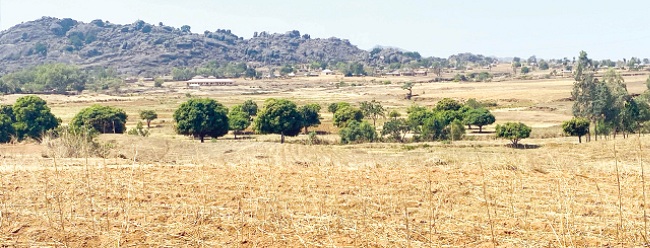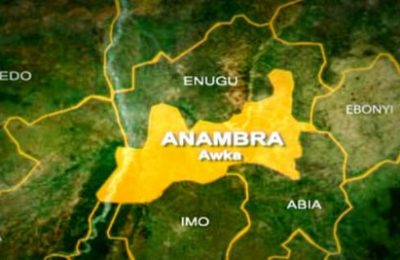
Jos, the Plateau State capital, is known as the Tin City. Nigeria began tin mining there and the nation profited greatly from it. Decades after the mining stopped, indigenous communities in the state are still reeling from the impacts. JUSTICE NWAFOR investigates the impacts of tin mining on indigenous communities in Plateau State in this two-part series. This first part investigates the impacts on farming and farmers. The second part will investigate the impacts on the health of residents.
At the turn of the 20th century, large deposits of tin ore were discovered in Plateau State, north-central Nigeria, and in 1905, large-scale mining operations started there. This created employment—skilled for the British in charge and unskilled for the locals—and resulted in foreign exchange for the colonial government at the time, as well as big impacts on the environment.

More than a century later, large-scale mining has ceased, leaving behind unlicensed small-scale mining carried out by mainly unemployed locals. These locals, particularly the women, depend on their earnings to feed their families. Some of them work more than eight hours a day for as little as $3. It is difficult to estimate the number of unlicensed artisanal miners in Plateau State because their activities are not documented.
“I don’t know if what we are doing affects me. What is important to me is that at the end of the day, I get money to buy food for my children,” said Janet Ngyang, whose duty is to pack dug-up sand near narrow pits for washing and tin extraction at one of the areas where locals still do small-scale mining.
Residents of the communities where the large-scale mining took place, like Ganawuri and Danwal, which are about 20 kilometres from Jos, the Plateau State capital, are dealing with the effects of the past and ongoing destruction of the environment caused by mining tin. Here, there are hardly any trees, as they were cut down in preparation for mining activities, giving the communities a desert-like look.
From the road that leads to the communities, abandoned mining ponds, some up to 70 metres deep and 50 metres wide, are visible. There are heaps of sand (mine tailings) hardened by years of exposure to the sun that punctuate farmlands. Gullies are a common sight here, and they, in large snake-like structures, connect to the large ponds. On farms, there are narrow but deep holes at nearly every turn, which endanger farmers and animals.
Impacts on farmers
Nearly every morning, 65-year-old Bung Sango leaves for his acha (Digitaria exilis), rice, cabbage, and tomato farms. He stays on the farm for nearly 12 hours before returning home around 6 p. m. This routine is more intense during the planting season because of the need to cultivate more land.
Sango told the Nigerian Tribune that the motivation for this work is the hope of a bountiful yield. But these hopes are usually dashed when harvest season nears.
“When the harvest comes, sometimes we get really sad because when you look at the crop yield and the effort you put in, you get discouraged and think that it is not worth the whole stress and investment.
“I would have stopped a long time ago, but I am still farming because I have no other means of getting money and the prices of things are increasing every day.
“I am afraid that in years to come, the younger generations may be totally discouraged from farming.”
This situation is largely due to poor soil fertility owing to the degradation that results from decades of tin mining.
Nafiu Adewale has a PhD in soil sciences, is an expert in soil nutrition and plant fertility, and Head of the Inspectorate and Accreditation Unit at the Nigeria Institute of Soil Science Research. He told the Nigerian Tribune that the complaints of farmers like Sango are real and could be scientifically proven.
He said that tin mining affects the physical and chemical properties of soil which determine how healthy or productive the soil can be.
“During tin mining, the soil is burrowed into (excavated), and the nutrients are lost,” he explained.
“When the physio-chemical properties are altered, the soil cannot be said to be healthy anymore,” he said. “The process decreases organic carbon, manifesting in lower yields.”
The properties of the soil, which are crucial for plant growth, are affected by tin mining, he said, noting that if they are altered, “crops planted on the soil cannot produce good yields.”
Dr Nafiu’s explanation is evident in Sango’s experiences. He told the Nigerian Tribune that yield has consistently been low in the past decade, though the mining took place many decades ago. “It is saddening to think of the harvest season because we would always come back disappointed.”
“The yields are so poor.”
Experts say the use of nitrogen, phosphorus, and potassium (NPK) fertilisers could help improve crop yields, but the high price (a 50kg bag costs around 35,000 naira or about $77) is a big challenge for poor indigenous farmers in the region. Even more, there are concerns that consistent use of NPK could lead to soil acidification—the decrease of the pH level of the soil, making the soil more acidic and affecting the rate at which plants take up nutrients from the soil.
In 2019, five scientists at the Department of Plant Sciences and Biotechnology, University of Jos, studied the effects of tin mine tailings (waste) on the growth and development of crops in Jos. Their findings showed that mine waste has effects on the growth and productivity of the common bean and, indeed, other crops in the city.
“The highly significant difference observed between the levels of mine tailings (left in open space in the mining areas) in respect to most of the characters assessed indicates that mine tailings have great effects on the growth and productivity of common beans,” the study revealed.
All these threaten the survival of not just the residents of Danwal (who are of the Aten indigenous group), but other communities and indigenous groups in Plateau State.
The Aten indigenous people, with a population estimate of 69,000, are predominantly farmers and are primarily found in Ganawuri (Riyom Local Government Area of Plateau State), which consists of eight districts, one of which is Danwal. There are about 18 villages in each district.
Aten people cultivate several cereals, vegetables, and crops, but one has a special place in their culture: acha (Digitaria exilis). Acha is an ancient small grain domesticated in Africa. In some parts of the continent, it is called fonio. While cultivating other grains and cereals, acha is given a special place and attention, so much so that a special granary called rumbu, in which threshed acha grains can be stored safely for many years, was designed for it.
Every Aten household farms acha. “It has a special place in our culture because it has helped families survive perilous times,” Yakubu Chaimang, the Ataa-Aten (paramount ruler) of Ganawuri, told the Nigerian Tribune in late January.
It is a matter of pride for Aten farmers to still have older acha and other cereals in their rumbu when new ones are harvested. But that pride, along with their harvests, is disappearing.
“Agriculture is central to our culture,” says Chaimang. “Anything that affects agriculture, our farms, affects us as a people.”
The double whammy of biodiversity loss and land scarcity
Jonathan Chakura, 56, is a father of four who farms in Ganawuri’s central district primarily to feed his family. Almost every farming season, he loses a portion of his farmland to rapidly expanding gullies.
Gullies form when water is channelled across unprotected land, which under natural conditions should be moderated by vegetation that generally holds the soil together, protecting it from excessive runoff and direct rainfall.
“I have lost so much land to gullies. The number of hectares I used to farm has decreased by almost half in the past years. This is because as the gullies keep expanding and the land keeps caving in, we keep running away from it. If you don’t run, it could consume you one day.”
He added that “crop productivity has drastically decreased. So, we are not just having less land to farm; we are also having lower yields from the small amount of remaining land. In a portion we used to get like seven bags of millet, now we get about three or four, despite spending a lot of money on fertiliser.”
Chakura’s complaints resonate with those of four other farmers the Nigerian Tribune spoke to—two each in Danwal and Ganawuri central district. There are concerns that the impacts may have far-reaching implications, not just on hunger and food security but also on the value system in the community and on young people.
Ngyang Boyi is the youth leader of Danwal. He told the Nigerian Tribune that part of the multi-faceted impact of the dwindling yields is the lack of interest the young people have shown in farming. “This issue has affected our youths,” he said. “They now prefer to engage in other things, including crimes and illegal mining, because most can’t endure spending time and effort farming and receiving little in return.”
Impacts on biodiversity
In 2012, Dr Solomon Jiya, who teaches geography and mining at the Ibrahim Badamasi Babangida University in Niger State, and his colleague, Musa Haruna, studied the biophysical impacts of tin mining activities on the environment and the impacts on land cover and land use in Bukuru—an area with the same level of devastation as Ganawuri and just less than 12 kilometres away. The study found that while there is little forest reserve for animals, there is now less arable land available for farming as a result of tin mining, which has also driven people out of farming.
“The impact of tin mining has greatly affected our natural ecosystem,” Jiya told the Nigerian Tribune in March. “Micro- and macroorganisms and plants have been stripped of their natural habitats due to tin mining activities, and this has led to an imbalance in our ecosystem. Birds are hardly found because the trees on which they should perch have long been felled for mining pits. The environment feels unnatural.”
In the same year, Michael Adegboye of the Federal College of Land Resources Technology, Kuru, researched the effect of mining on farming in the state, with a focus on the Jos South area. Adegboye’s study also found that mining activities (in 1938, Nigeria was exporting 10,486 tons of tin ore to Britain, which increased to 11,164 tons in 1951–1952 and 11,942 tons in 1952–1953) led to varying degrees of farmland reduction, ranging from soil erosion, the swampy nature of the neglected mined excavation, mine dumps, pits, and industrial use of the arable land.
“The farmers experienced low productivity in crop farming, land fragmentation, land disputes and conflicts, and unemployment,” it revealed.
The Plateau State Commissioner for Environment, Elisha Bitrus Shehu, and Commissioner for Agriculture, Hosea Finangwai, did not respond to calls, SMS, or WhatsApp messages sent to their cellphone numbers as of the time of filing this report.
Government reclaiming gullies
However, in a media report, former Commissioner for Environment, Usman Idi, said the state government was troubled by the situation and was working to reclaim some of the gullies in the state.
“We have identified areas for reclamation, and some of the areas have already been reclaimed,” he said.
Idi further explained that “the state and federal governments and the Ministry of the Environment are already collaborating to see how some of those areas can be recovered. That has already started. Now some farmers can go back to begin their farming activities,” he said.
The ministry claims it has reclaimed 15 identified gully erosion sites in the state, and reclamation work is ongoing in many of them, but it did not list them.
It also stated that it is participating in the World Bank’s Nigeria Erosion and Watershed Management Project (NEWMAP).
A 2020 report showed that the ministry had an agreement with a private company to reconstruct the Mangu Market gully erosion.
The government’s remediation efforts have yet to reach Ganawuri, the Nigerian Tribune found.
For Chakura, remediation is not just the filling of the pits in his community; it means getting a part of his life back. “The government should help us fix this issue because we don’t have any other home,” he said.
“This community is our life, and fixing the problems tin mining has caused is like getting a part of our lives back.”
This story was produced with support from Internews’ Earth Journalism Network.








